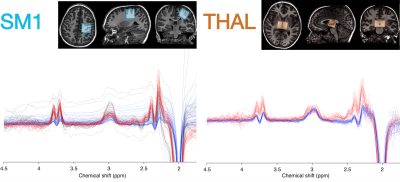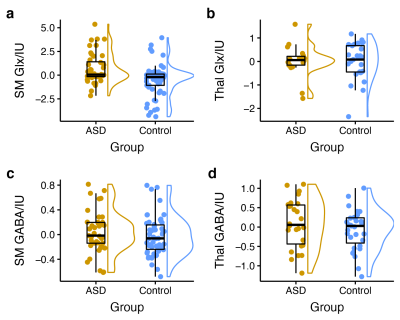Georg Oeltzschner1,2, Jason He3, Mark Mikkelsen1,2, Alyssa DeRonda4, Deana Crocetti4, Stewart H. Mostofsky4,5,6, Richard A.E. Edden1,2, and Nicolaas A.J. Puts3
1Russell H. Morgan Department of Radiology and Radiological Science, The Johns Hopkins University School of Medicine, Baltimore, MD, United States, 2F. M. Kirby Research Center for Functional Brain Imaging, Kennedy Krieger Institute, Baltimore, MD, United States, 3Department of Forensic and Neurodevelopmental Sciences, Sackler Institute for Translational Neurodevelopment, Institute of Psychiatry, Psychology, and Neuroscience, King's College London, London, United Kingdom, 4Center for Neurodevelopmental and Imaging Research, Kennedy Krieger Institute, Baltimore, MD, United States, 5Department of Psychiatry, The Johns Hopkins University School of Medicine, Baltimore, MD, United States, 6Department of Neurology, The Johns Hopkins University School of Medicine, Baltimore, MD, United States
1Russell H. Morgan Department of Radiology and Radiological Science, The Johns Hopkins University School of Medicine, Baltimore, MD, United States, 2F. M. Kirby Research Center for Functional Brain Imaging, Kennedy Krieger Institute, Baltimore, MD, United States, 3Department of Forensic and Neurodevelopmental Sciences, Sackler Institute for Translational Neurodevelopment, Institute of Psychiatry, Psychology, and Neuroscience, King's College London, London, United Kingdom, 4Center for Neurodevelopmental and Imaging Research, Kennedy Krieger Institute, Baltimore, MD, United States, 5Department of Psychiatry, The Johns Hopkins University School of Medicine, Baltimore, MD, United States, 6Department of Neurology, The Johns Hopkins University School of Medicine, Baltimore, MD, United States
This study investigates relationships between
sensory impairment in ASD, vibrotactile perceptual thresholds, and edited MRS
measures of GABA and Glx. Results suggest that higher Glx levels in
sensorimotor cortex may be related to abnormal touch perception.

Figure
1: Example voxel placement in the primary sensorimotor cortex (SM1) and thalamus
(THAL), along with respective data. Spectra are color-coded by acquisition
phase: gray = macromolecule-suppressed MEGA-PRESS (Phase 1); blue =
macromolecule-suppressed MEGA-PRESS with prospective frequency correction (Phase
2); red = HERMES (Phase 3).

Figure
2: Group comparison of tissue-corrected metabolite
levels (residuals after linear-mixed effects model accounting for age, sex, and
acquisition phase) between children with ASD and typically developing children.
Sensorimotor Glx levels are significantly higher in children with ASD (a),
while no significant group differences were found for thalamus Glx (b),
sensorimotor GABA (c), or thalamus GABA (d).
